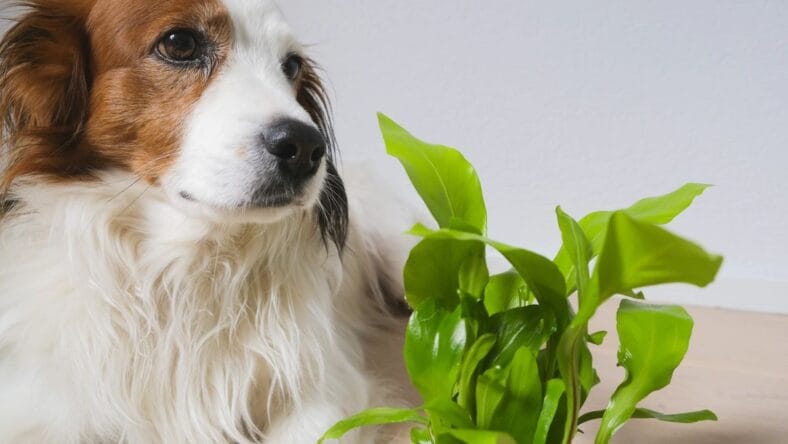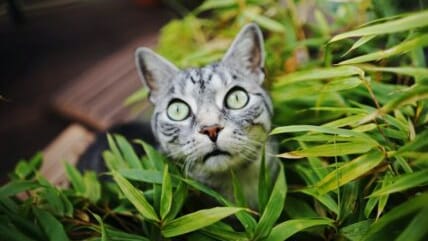
Pets seem to get into everything, even the dangerous parts, and unfortunately being a pet and plant parent is troublesome. While plants are a beautiful decoration piece for your home, there are some plants you might want to avoid when having a pet.
While not all plants are bad, you definitely need to make sure you do your research before bringing home your furry or foliage friend. One such plant that can cause some issues is ivy. While beautiful, what happens when dogs and ivy are brought together? Read more to find out everything you need to know about dogs and ivy.
RELATED: Best Dog Toys for Heavy Chewers That Won’t Get Immediately Destroyed
Is Ivy Toxic for Dogs?

Unfortunately, like cats, ivy is toxic to dogs.
Also known as the English Ivy, Branching Ivy, Glacier Ivy, Needlepoint Ivy, Sweetheart Ivy, or California Ivy, this can be incredibly toxic for your pup. According to the American Society for the Prevention of Cruelty to Animals, or ASPCA, this plant is toxic to cats, dogs and even horses.
Why is it Toxic?
The toxic principle in the ivy is called hederagenin, which is a triterpenoid saponin and polyacetylene compounds that causes gastrointestinal disturbances and irritation to the skin and mucous membranes.
This plant consists of 12-15 evergreen climbing vines that can reach up to 20-30 meters. In its juvenile stage, the leaves are lobed, but once it matures, the leaves can change to a more oval shape. Flowers and berries often develop when maturing as well. While Ivy can be beautiful, dogs and ivy just do not go together.
What are the Signs of Ivy Poisoning?

The ASPCA says that some signs to know if your dog has Ivy Poisoning is if they’re vomiting, hypersalivating like drooling, and has diarrhea.
The American Kennel Club, or AKC, says that some more common signs could be behavioral changes, like lethargy, blisters and red, swollen skin, itching, loss of appetite and even abdominal pain.
How to Treat Ivy Poisoning on Dogs
Depending on the severity, you might be able to do at home treatments or might want to go to the vet for extra care. If the signs are mild, like itching, then you can do more at-home treatments such as an oatmeal or aloe shampoo bath. Make sure to really scrub the shampoo into their fur and skin and let it soak for a while to ensure best outcome.
You can also apply a wet, cold compress to the inflicted area to soothe the itching, or even coconut oil to help the pain and itch. Make sure to give your pup plenty of fluids and bland food to help with an upset stomach while making sure they don’t get dehydrated.
For more extreme cases, like if your pup is lethargic, losing their appetite, blistering, or having trouble breathing or moving around, you should seek medical attention immediately. No matter if your pup brushed up against the plant or even ate it, there can be serious consequences to your pet being around Ivy.
Even if they have light itching at first and might see like a mild case, make sure that you keep an eye on your furry friend as something milk can turn serious at any minute. All in all, it’s best to avoid putting dogs and ivy together.
What About Other Plants?
Unfortunately, it’s not just Ivy that you should watch out for. While you can still find plants that are perfect for your home, doing extensive research to make sure they’re not harmful for your pets is crucial.
While dogs and ivy are not compatible, that doesn’t mean there aren’t other great alternatives. Read more to find out some other toxic and non-toxic plants that you can find as common household plants.
CHECK OUT: Tips To Keep Your House Clean with Pets
Fiddle Leaf Fig is Infamous but Deadly

One of the most commonly suggested plants for interior decorators and houseplant enthusiasts is the Fiddle Leaf Fig, or Ficus Lyrata. It’s a medium to large houseplant with a thin trunk and large, heavily veined, glossy fiddled-shaped leaves. They’re fast growers and can reach decent heights indoors.
But even though these are some of the more popular plants around right now, they are actually pretty harmful to dogs. Their sap contains calcium oxalate crystals, which are microscopic needles that scratch the mouth, tongue and throat. This can cause irritation, vomiting, diarrhea, and even loss of appetite, which can become life-threatening symptoms if not treated properly and quickly.
The leaves, however, are not as toxic. While they are mildly poisonous, your pups would need to have long-lasting contact for the symptoms to be bad.
Never Trust a Lily
While beautiful and a common household and outdoor plant, lilies should be avoided with both cats and dogs. Like dogs and ivy, lilies can cause some nasty symptoms for pups. While they’re almost life-threatening for cats, they only cause gastrointestinal issues for dogs.
And unfortunately, there are so many variations of lilies, and while some might not be all bad, it truly is best to avoid them all. Some lilies, like Calla Lily, releases a substance that burns and irritates a dog’s mouth and stomach, and the symptoms can be mild or severe. However, the rule of thumb for lilies is to assume the worst and pick up something else.
Some other common plants that you might want that is toxic for dogs include:
- Philodendron
- Aloe Vera
- Bird of Paradise
- Hydrangea
- Peony
- Tulip
- Hyacinth
- Daffodil
- Chrysanthemum
Boston Fern is the Way to Go

Boston Fern’s are a great house plant because they’re beautiful and have a reputation for being hearty and easy to grow. You can either have then in a pot on the floor or have then in a basket hanging above your patio. These plants are lush, full and completely safe for cats and dogs.
They’re great outdoors and in, are native to the cold and harsh winter climates so they’re the perfect beginner plant for those that have furry friends and want a safe environment.
Areca Palms are Perfect
Palms are a great plant for your indoor space as they’re large and vibrant, and most of them are non-toxic for your furry friends. While you definitely want to check before purchasing any sort of palms, one specific palm that is no question to being safe is the Areca Palm. These floor sitting plants definitely make a statement for your space. They’re gorgeous, have large leaves, tall growth and thick stalks.
They enjoy filtered sunlight or a full sun, and have a bamboo-like texture, making them hardy and robust. While the Fern is a much easier plant to grow, this is a great choice for intermediate plant parents that want to try their hand a bit more eccentric plant.
If you’re interested in more plants, these are some common plants that are not toxic to dogs:
- Spider Plant
- Swedish Ivy
- African Violet
- Gerbera Daisy
- Orchid
- Hoya Obovata
- Banana Plant
- Peperomia
In Conclusion
While having plants in your home can make a huge difference to your mood, health and lively hood, there are some plants that you’re better off avoiding when having a flurry friend around the home. Dogs and ivy don’t mix, along with several other plants, but thankfully that doesn’t mean that you can’t have any foliage.
There are some great options for those that want to spruce up their living space with some greenery, just make sure you do enough research before inviting both in the home. At the end of the day, you want to make sure that your pup can live in your space stress free and without risk of harming themselves. For more information on plants that are toxic or safe with animals, check out the ASPCA toxic plant list for dogs and cats.
Explore More About:Home & Garden
